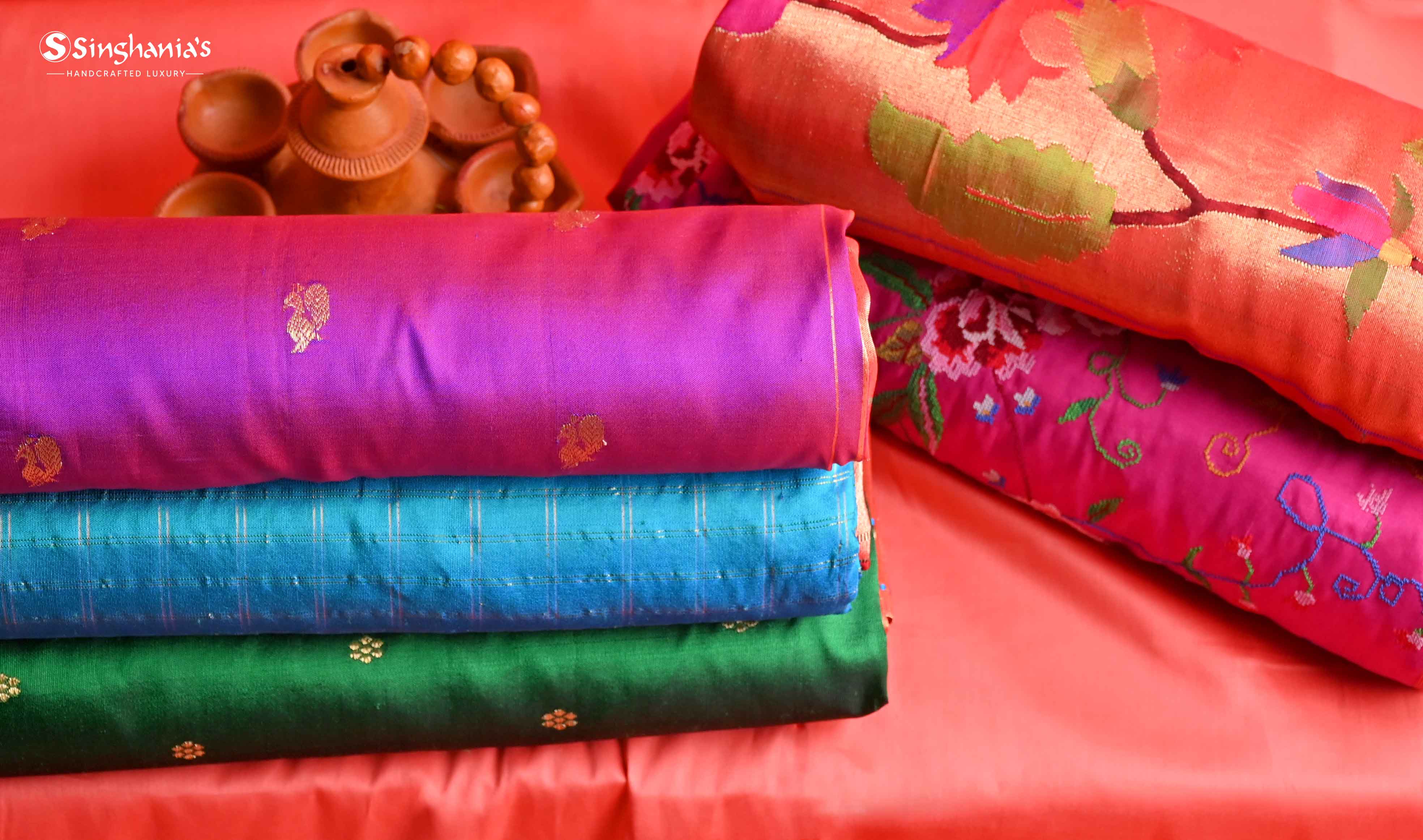
India has a long-standing love affair with the handloom, with priceless weaves being conserved and handed down from mother to daughter as cherished heirlooms. The Paithani wedding saree is the star of this group. India has one of the most extensive traditions of woven textiles made from various materials and employs a range of material processing and weaving methods. Each area has its own unique weaving and design aesthetic. The Paithani saree of Maharashtra state is a weaving of intricate designs and painstaking labor in addition to being a silk saree in beautiful hues. Explore with us the appeal and importance of Maharashtrian Paithani in wedding ceremonies.
-What are Paithani sarees?
In Maharashtrian weddings, the bride usually chooses a Paithani wedding saree as a representation of her heritage and culture. Rich colors and intricate hand-woven designs are hallmarks of the Paithani, a traditional silk saree from Maharashtra. It is typically draped using a special technique called the Nauvari, which includes wrapping the saree around the waist and thighs to resemble trousers. In addition to the bride, other female family members also dress in Paithani sarees for the wedding ritual. The saree is regarded as a sign of deference and symbolizes Maharashtra's rich cultural heritage.
-Paithani saree origin:
The Paithani saree origin is believed to have taken place more than 2000 years ago, and the weaving designs and techniques have been passed down through the generations of weavers. The royal families of the nearby medieval village of Paithan were the first to don Paithani sarees. The saree, which still bears the name of the town, is thought to have been made by first weaving the best Chinese silk and locally spun zari. This saree is a manifestation of years of extravagance and Indian hand-weaving craftsmanship. The extravagant and liberal use of gold, along with the patterns influenced by flowers and birds, distinguish each piece.
-How Does Marathi Paithani Sarees Look Like?
The exquisite handwoven patterns, vivid hues, and luxurious silk fabric of the Marathi Paithani saree are well known. The saree is draped using a special technique called Nauvari, which includes wrapping it around the waist and legs to resemble trousers. The pallu, or loose end of the saree that is draped over the shoulder, and a wide border are characteristic features of sarees. The border and pallu are decorated with intricate patterns and themes drawn from traditional and natural art forms. The sarees come in a variety of colors, from vivid tones like red, green, and yellow to delicate pastel shades like pink, peach, and lavender. Whereas historically, only three colors were documented. These are: 1) Kalichandrakala (Black Saree with red border) 2. Raghu (Parrot Green colored saree) 3. Shirodak (White colored saree). To enhance the saree's attractiveness and refinement, it is typically worn with a matching blouse and traditional jewellery.
-Which motifs are usually found on a Paithani saree?
Paithani sarees are renowned for their intricate handwoven patterns and patterns, which draw their inspiration from nature and conventional art forms. Paithani Maharashtrian saree frequently features the following motifs:
-
Peacock: A representation of elegance, beauty, and grandeur, the peacock motif is a common feature of the Maharashtrian Paithani saree.
-
Lotus: A common design element in Paithani sarees, the lotus flower symbolizes purity, enlightenment, and attractiveness.
-
Vines: Symbolising growth, vitality, and wealth, vines are a common design feature in Paithani sarees.
-
Asawali: Asawali is a flower design that is frequently used on Paithani sarees. It has a design of tiny flowers arranged in groups, signifying joy and happiness.
-
Bangdi Mor: The peacock and the bangle are two patterns that are combined to create Bangdi Mor, standing for success and good fortune.
Fine silk strands are used to weave these motifs into the saree, resulting in intricate patterns that are distinctive to the Maharashtrian Paithani saree.
-What is the importance of Maharashtrian Paithani in Wedding?
Are you interested in learning why the Maharashtrian Paithani saree is used at weddings? As a symbol of Maharashtrian tradition and culture, it occupies a unique place in weddings there. To add to the ceremony's formality, the bride and other feminine family members frequently don Paithani sarees. The bridal Paithani sarees also appeal to customers outside of Marathi Matrimony. Even people from outside India appreciate the creative quality of these sarees. In the era of machines, these sarees are truly a labor of love and devotion. Given that Maharashtrian brides have favored it for millennia, the vibrant color scheme's cultural importance is amply highlighted. Many young women's continued choice of traditional and formal attire may put older people at ease.
Bottom Line
The saree is considered the Queen of sarees in India because of its 2000-year history. Due to its undeniable allure and closed weaving technique, which makes it easy to wear with accessories without tangles, the rich saree is every Marathi bride's fantasy. A Paithani Maharashtra saree is an absolute necessity in your wardrobe if you adore India and its vibrant cultures.




